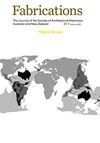Under the Radome: The Architecture of American Cold War Surveillance
IF 0.3
0 ARCHITECTURE
Fabrications-The Journal of the Society of Architectural Historians Australia and New Zealand
Pub Date : 2021-05-04
DOI:10.1080/10331867.2021.1945732
引用次数: 0
Abstract
ABSTRACT Radomes, the iconic structures protecting sensitive radar antennas from wind, weather, and the prying eyes of adversaries, marked and maintained the geographic boundaries of America’s Cold War. The radome’s unique architecture, most commonly a rigid geodesic dome, captured the essential tensions of the Cold War, instantly recognisable but inaccessible; transparent (to radio waves) but opaque (to the naked eye); highly classified but often hidden in plain sight. Along the Distant Early Warning (DEW) Line inside the Arctic Circle in Canada and in the arid desert of the Australian outback, radomes became the telltale signs of US surveillance and spy bases; a network constructed in partnership with American allies but politically fraught for their host countries, which had little political or technical control over them. Those bases, and the communities that grew up around them, have endured, but their new missions have raised troubling new questions of national sovereignty, dependency, and privacy.雷达罩下:美国冷战监视的架构
摘要雷达罩是保护敏感雷达天线免受风、天气和对手窥探的标志性结构,标志并维护了美国冷战时期的地理边界。天线罩独特的结构,最常见的是刚性测地线圆顶,捕捉到了冷战时期的基本紧张局势,可以立即识别但无法接近;透明(对无线电波)但不透明(对肉眼);高度机密,但通常隐藏在显眼的地方。沿着加拿大北极圈内和澳大利亚内陆干旱沙漠中的远程预警线,雷达罩成为美国监视和间谍基地的标志;一个与美国盟友合作建立的网络,但对东道国来说政治上充满了担忧,因为东道国对他们几乎没有政治或技术控制。这些基地以及在他们周围长大的社区一直存在,但他们的新使命提出了令人不安的国家主权、依赖性和隐私等新问题。
本文章由计算机程序翻译,如有差异,请以英文原文为准。
求助全文
约1分钟内获得全文
求助全文
来源期刊

CiteScore
0.50
自引率
25.00%
发文量
26
 求助内容:
求助内容: 应助结果提醒方式:
应助结果提醒方式:


